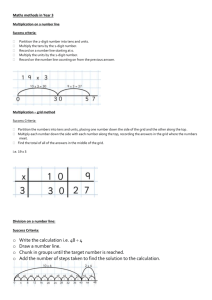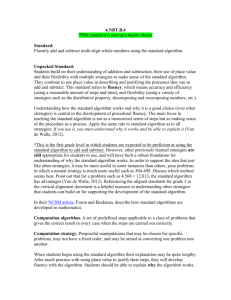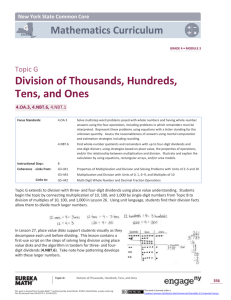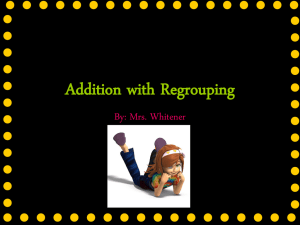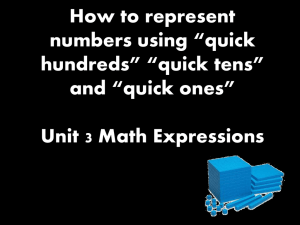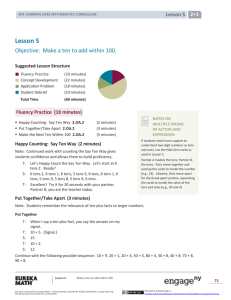Multiply 3- and 4-digit numbers by 1-digit numbers
advertisement
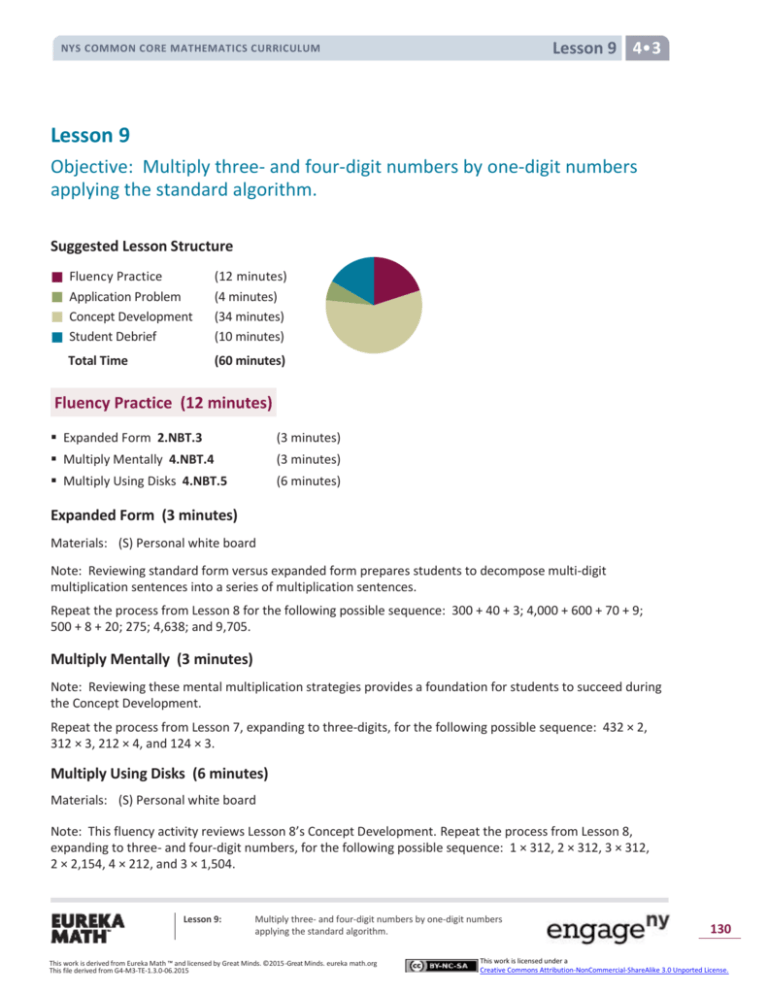
Lesson 9 4 3 NYS COMMON CORE MATHEMATICS CURRICULUM Lesson 9 Objective: Multiply three- and four-digit numbers by one-digit numbers applying the standard algorithm. Suggested Lesson Structure Fluency Practice Application Problem Concept Development Student Debrief Total Time (12 minutes) (4 minutes) (34 minutes) (10 minutes) (60 minutes) Fluency Practice (12 minutes) Expanded Form 2.NBT.3 (3 minutes) Multiply Mentally 4.NBT.4 (3 minutes) Multiply Using Disks 4.NBT.5 (6 minutes) Expanded Form (3 minutes) Materials: (S) Personal white board Note: Reviewing standard form versus expanded form prepares students to decompose multi-digit multiplication sentences into a series of multiplication sentences. Repeat the process from Lesson 8 for the following possible sequence: 300 + 40 + 3; 4,000 + 600 + 70 + 9; 500 + 8 + 20; 275; 4,638; and 9,705. Multiply Mentally (3 minutes) Note: Reviewing these mental multiplication strategies provides a foundation for students to succeed during the Concept Development. Repeat the process from Lesson 7, expanding to three-digits, for the following possible sequence: 432 × 2, 312 × 3, 212 × 4, and 124 × 3. Multiply Using Disks (6 minutes) Materials: (S) Personal white board Note: This fluency activity reviews Lesson 8’s Concept Development. Repeat the process from Lesson 8, expanding to three- and four-digit numbers, for the following possible sequence: 1 × 312, 2 × 312, 3 × 312, 2 × 2,154, 4 × 212, and 3 × 1,504. Lesson 9: Multiply three- and four-digit numbers by one-digit numbers applying the standard algorithm. This work is derived from Eureka Math ™ and licensed by Great Minds. ©2015 -Great Minds. eureka math.org This file derived from G4-M3-TE-1.3.0-06.2015 130 This work is licensed under a Creative Commons Attribution-NonCommercial-ShareAlike 3.0 Unported License. Lesson 9 4 3 NYS COMMON CORE MATHEMATICS CURRICULUM Application Problem (4 minutes) Calculate the total amount of milk in three cartons if each carton contains 236 mL of milk. Note: This problem is a review of Lesson 8, practicing three-digit by one-digit multiplication. Concept Development (34 minutes) Materials: (T) Ten thousands place value chart (Lesson 7 Template) (S) Personal white board, ten thousands place value chart (Lesson 7 Template) Problem 1: Represent and solve 6 × 162 in the place value chart. Relate the process to solving using the standard algorithm. T: S: T: T: S: T: T: S: Represent 6 × 162 on your place value chart using the repeated addition way. Work with a partner to solve. Was it necessary to regroup? Yes. On my place value chart, I had 6 hundreds, 36 tens, and 12 ones. I regrouped 10 ones for 1 ten and 30 tens for 3 hundreds. My answer is 9 hundreds, 7 tens, and 2 ones. Write the expression 6 × 162 again vertically on your personal white boards. Let’s find a faster way to express your answer. Use the place value chart to help. Tell me what happened in the ones column of your place value chart. I multiplied 6 times 2 ones to get 12 ones. We regrouped 10 ones for 1 ten and were left with 2 ones. Record the number of regrouped tens on the line under the tens column. Record the number of ones in the ones place. Tell me what happened in the tens column of your place value chart. I multiplied 6 times 6 tens and got 36 tens. We exchanged 30 tens for 3 hundreds and were left with 6 tens. But, we have the 1 ten regrouped from the ones, so 36 tens plus the 1 ten makes 37 tens. So, we have 3 hundreds and 7 tens after we regroup. Lesson 9: Multiply three- and four-digit numbers by one-digit numbers applying the standard algorithm. This work is derived from Eureka Math ™ and licensed by Great Minds. ©2015 -Great Minds. eureka math.org This file derived from G4-M3-TE-1.3.0-06.2015 131 This work is licensed under a Creative Commons Attribution-NonCommercial-ShareAlike 3.0 Unported License. Lesson 9 4 3 NYS COMMON CORE MATHEMATICS CURRICULUM T: S: T: T: S: T: S: T: S: Record the number of hundreds on the line in the hundreds column. Record the number of tens in the tens place. What about the 1 that was written on the line in the tens place, do I need it anymore? No, we counted it already. Right, so if we’re done with it, let’s get rid of it. Cross it out. Now, let’s look at the hundreds. What was the value of the hundreds? We had 6 times 1 hundred equals 6 hundreds. 6 hundreds plus the 3 hundreds we regrouped equals 9 hundreds. Since there’s no need to regroup, write the number of hundreds in the hundreds place. Have we already counted the 3 hundreds we regrouped? Yes! Cross it out. What’s the product? 972. That’s the same number we got with the place value chart! Problem 2: Solve 5 × 237 using the partial products algorithm. Then solve using the standard algorithm, and relate the two methods to each other. T: Write the expression 5 × 237 vertically on your board. Draw and solve using partial products. Students work individually or in pairs to draw and solve using partial products. T: S: T: S: MP.2 T: S: T: S: T: S: T: S: T: T: Now, let’s solve using the standard algorithm. Starting in the ones column, what do we do? We multiply 5 times 7 ones and get 35 ones. Tell your partner how you record 35 ones as partial products. 35 ones is 3 tens 5 ones, so we record 3 tens in the tens column and 5 ones in the ones column on the same line. Let’s record 3 tens 5 ones using the standard algorithm. (Record 3 tens on the line and 5 ones in the ones column.) Tell your partner what you notice about this recording. The 3 tens is on the line in the tens like in addition and the 5 ones is in the ones place, so it still shows 35 ones. We add partial products together, so the 3 tens on the line means it will get added to the product. Working in the tens column, what do we do next? We multiply 5 times 3 tens and get 15 tens. 15 tens was recorded on the second line in the partial products method. For the standard algorithm, add 3 tens to 15 tens. 18 tens. Say 18 tens as hundreds and tens. 1 hundred 8 tens. Record 1 hundred on the line in the hundreds column and 8 tens in the tens column. Cross out 3 tens because it was added. What do we do next? Lesson 9: Multiply three- and four-digit numbers by one-digit numbers applying the standard algorithm. This work is derived from Eureka Math ™ and licensed by Great Minds. ©2015 -Great Minds. eureka math.org This file derived from G4-M3-TE-1.3.0-06.2015 132 This work is licensed under a Creative Commons Attribution-NonCommercial-ShareAlike 3.0 Unported License. Lesson 9 4 3 NYS COMMON CORE MATHEMATICS CURRICULUM S: T: S: T: S: T: S: Next, we multiply 5 times 2 hundreds and get 10 hundreds. But, in the standard algorithm we have to add the 1 hundred that is on the line to make 11 hundreds. Remember to cross off the 1 since we have already included it in our answer. Because there are no more numbers to multiply, we can just record 11 hundreds directly in the product, which is…? 1,185. Look back at the work that you did when you solved using partial products. What was the product? 1,185. It’s the same thing. We came up with the same product even though our methods were different. NOTES ON What are the advantages to the standard algorithm? MULTIPLE MEANS We record our answer on one line. We are doing all OF ENGAGEMENT: of the calculations in a few steps. Repeat using 6 × 716. Problem 3: Multiply three- and four-digit numbers by one-digit numbers applying the standard algorithm. Write or project the following: Shane measured 457 mL of water in a beaker. Olga measured 3 times as much water. How much water did they measure altogether? T: S: T: S: T: S: T: S: T: S: Have students use and compare the two methods: partial products and the standard algorithm. Encourage learners to analyze their proficiency and efficiency using each method. Guide students to ask, “What mistakes do I make? When? Which method is easier for me? When? Why?” Draw a tape diagram and discuss with a partner how you would solve this problem. We would multiply 4 times 457 to solve this problem. If Olga measured 3 times as much water as Shane, we multiply by four to find the total. Solve using the standard algorithm. What do we multiply first? Four times 7 ones equals 28 ones. Show me how to record 28 ones. I write the 2 on the line under the tens place. I write the 8 in the ones. What do we multiply next? Four times 5 tens is 20 tens plus 2 tens that were changed from the ones. I have 22 tens. I cross off the 2 because I just included it in the total for the tens. I write 22 tens in my answer. The 2 is written in the hundreds place on the line to show that we regrouped to the hundreds, and the 2 is written in the tens. What do we multiply next? Four times 4 hundreds equals 16 hundreds. Then, I add 2 hundreds to get 18 hundreds. I cross off the 2 because I included it in the total hundreds. Because there are no more numbers to multiply, I record 18 hundreds directly in my product. The product is 1,828. Lesson 9: Multiply three- and four-digit numbers by one-digit numbers applying the standard algorithm. This work is derived from Eureka Math ™ and licensed by Great Minds. ©2015 -Great Minds. eureka math.org This file derived from G4-M3-TE-1.3.0-06.2015 133 This work is licensed under a Creative Commons Attribution-NonCommercial-ShareAlike 3.0 Unported License. Lesson 9 4 3 NYS COMMON CORE MATHEMATICS CURRICULUM Problem Set (10 minutes) Students should do their personal best to complete the Problem Set within the allotted 10 minutes. For some classes, it may be appropriate to modify the assignment by specifying which problems they work on first. Some problems do not specify a method for solving. Students solve these problems using the RDW approach used for Application Problems. Student Debrief (10 minutes) Lesson Objective: Multiply three- and four-digit numbers by one-digit numbers applying the standard algorithm. The Student Debrief is intended to invite reflection and active processing of the total lesson experience. NOTES ON MULTIPLE MEANS OF REPRESENTATION: Many learners, in addition to English language learners, will appreciate a review of standard algorithm and partial products as new math language. Point out, if beneficial, smaller words embedded in these compound words, such as part in partial. Students may benefit from recording these new terms with clarifying examples in their own math dictionaries. Invite students to review their solutions for the Problem Set. They should check work by comparing answers with a partner before going over answers as a class. Look for misconceptions or misunderstandings that can be addressed in the Debrief. Guide students in a conversation to debrief the Problem Set and process the lesson. Any combination of the questions below may be used to lead the discussion. Explain to your partner how you used partial products and the standard algorithm to solve Problems 1(a) and 1(b). Why do both methods work? How are they different? Look at the questions in Problem 2. Which ones would give you estimates that are very close to the actual product if you rounded the larger number to the hundreds place? Do you think that you would get a different answer for Problem 4 if the question instead asked you to find 457 times as much as 9? Why or why not? Explain to your partner how you solved Problem 7. How did you keep track of what each of the numbers meant? How could you use a tape diagram to represent the work you did on the Application Problem? What significant vocabulary did we use today? Lesson 9: Multiply three- and four-digit numbers by one-digit numbers applying the standard algorithm. This work is derived from Eureka Math ™ and licensed by Great Minds. ©2015 -Great Minds. eureka math.org This file derived from G4-M3-TE-1.3.0-06.2015 134 This work is licensed under a Creative Commons Attribution-NonCommercial-ShareAlike 3.0 Unported License. Lesson 9 4 3 NYS COMMON CORE MATHEMATICS CURRICULUM Exit Ticket (3 minutes) After the Student Debrief, instruct students to complete the Exit Ticket. A review of their work will help you assess the students’ understanding of the concepts that were presented in the lesson today and plan more effectively for future lessons. The questions may be read aloud to the students. Lesson 9: Multiply three- and four-digit numbers by one-digit numbers applying the standard algorithm. This work is derived from Eureka Math ™ and licensed by Great Minds. ©2015 -Great Minds. eureka math.org This file derived from G4-M3-TE-1.3.0-06.2015 135 This work is licensed under a Creative Commons Attribution-NonCommercial-ShareAlike 3.0 Unported License. Lesson 9 Problem Set 4 3 NYS COMMON CORE MATHEMATICS CURRICULUM Name Date 1. Solve using each method. Partial Products a. Standard Algorithm 3 4 × 4 3 Partial Products 4 × b. 4 2 × 2 Standard Algorithm 4 3 2 × 2 0 4 4 3 2. Solve. Use the standard algorithm. a.aa. 2 5 × d. 1 b. 3 × 0 5 3 4 × Lesson 9: 3 × e. 4 1 5 c. 6 1 6 5 3 × f. 3 × Multiply three- and four-digit numbers by one-digit numbers applying the standard algorithm. This work is derived from Eureka Math ™ and licensed by Great Minds. ©2015 -Great Minds. eureka math.org This file derived from G4-M3-TE-1.3.0-06.2015 9 9 2 6 136 This work is licensed under a Creative Commons Attribution-NonCommercial-ShareAlike 3.0 Unported License. NYS COMMON CORE MATHEMATICS CURRICULUM 3. The product of 7 and 86 is ________. Lesson 9 Problem Set 4 4. 9 times as many as 457 is _________. 5. Jashawn wants to make 5 airplane propellers. He needs 18 centimeters of wood for each propeller. How many centimeters of wood will he use? Lesson 9: Multiply three- and four-digit numbers by one-digit numbers applying the standard algorithm. This work is derived from Eureka Math ™ and licensed by Great Minds. ©2015 -Great Minds. eureka math.org This file derived from G4-M3-TE-1.3.0-06.2015 137 This work is licensed under a Creative Commons Attribution-NonCommercial-ShareAlike 3.0 Unported License. NYS COMMON CORE MATHEMATICS CURRICULUM Lesson 9 Problem Set 4 6. One game system costs $238. How much will 4 game systems cost? 7. A small bag of chips weighs 48 grams. A large bag of chips weighs three times as much as the small bag. How much will 7 large bags of chips weigh? Lesson 9: Multiply three- and four-digit numbers by one-digit numbers applying the standard algorithm. This work is derived from Eureka Math ™ and licensed by Great Minds. ©2015 -Great Minds. eureka math.org This file derived from G4-M3-TE-1.3.0-06.2015 138 This work is licensed under a Creative Commons Attribution-NonCommercial-ShareAlike 3.0 Unported License. Lesson 9 Exit Ticket 4 3 NYS COMMON CORE MATHEMATICS CURRICULUM Name Date 1. Solve using the standard algorithm. a. b. 6 0 × 8 5 9 × 7 4 7 2. Morgan is 23 years old. Her grandfather is 4 times as old. How old is her grandfather? Lesson 9: Multiply three- and four-digit numbers by one-digit numbers applying the standard algorithm. This work is derived from Eureka Math ™ and licensed by Great Minds. ©2015 -Great Minds. eureka math.org This file derived from G4-M3-TE-1.3.0-06.2015 139 This work is licensed under a Creative Commons Attribution-NonCommercial-ShareAlike 3.0 Unported License. Lesson 9 Homework 4 3 NYS COMMON CORE MATHEMATICS CURRICULUM Name Date 1. Solve using each method. Partial Products a. Standard Algorithm 4 6 _× 4 6 2_ × Partial Products Standard Algorithm 3 1 5 3 1 5 b. 2 × 4 × 4 2. Solve using the standard algorithm. a. 2 3 × d. 2 b. 4 4 4 × 0 3 Lesson 9: 1 4 × e. 2 c. 3 6 5 × 0 7 × f. 8 × 4 7 3 Multiply three- and four-digit numbers by one-digit numbers applying the standard algorithm. This work is derived from Eureka Math ™ and licensed by Great Minds. ©2015 -Great Minds. eureka math.org This file derived from G4-M3-TE-1.3.0-06.2015 1 8 4 9 140 This work is licensed under a Creative Commons Attribution-NonCommercial-ShareAlike 3.0 Unported License. NYS COMMON CORE MATHEMATICS CURRICULUM Lesson 9 Homework 4 3 3. What is the product of 8 and 54? 4. Isabel earned 350 points while she was playing Blasting Robot. Isabel’s mom earned 3 times as many points as Isabel. How many points did Isabel’s mom earn? 5. To get enough money to go on a field trip, every student in a club has to raise $53 by selling chocolate bars. There are 9 students in the club. How much money does the club need to raise to go on the field trip? Lesson 9: Multiply three- and four-digit numbers by one-digit numbers applying the standard algorithm. This work is derived from Eureka Math ™ and licensed by Great Minds. ©2015 -Great Minds. eureka math.org This file derived from G4-M3-TE-1.3.0-06.2015 141 This work is licensed under a Creative Commons Attribution-NonCommercial-ShareAlike 3.0 Unported License. NYS COMMON CORE MATHEMATICS CURRICULUM Lesson 9 Homework 4 3 6. Mr. Meyers wants to order 4 tablets for his classroom. Each tablet costs $329. How much will all four tablets cost? 7. Amaya read 64 pages last week. Amaya’s older brother, Rogelio, read twice as many pages in the same amount of time. Their big sister, Elianna, is in high school and read 4 times as many pages as Rogelio did. How many pages did Elianna read last week? Lesson 9: Multiply three- and four-digit numbers by one-digit numbers applying the standard algorithm. This work is derived from Eureka Math ™ and licensed by Great Minds. ©2015 -Great Minds. eureka math.org This file derived from G4-M3-TE-1.3.0-06.2015 142 This work is licensed under a Creative Commons Attribution-NonCommercial-ShareAlike 3.0 Unported License.


